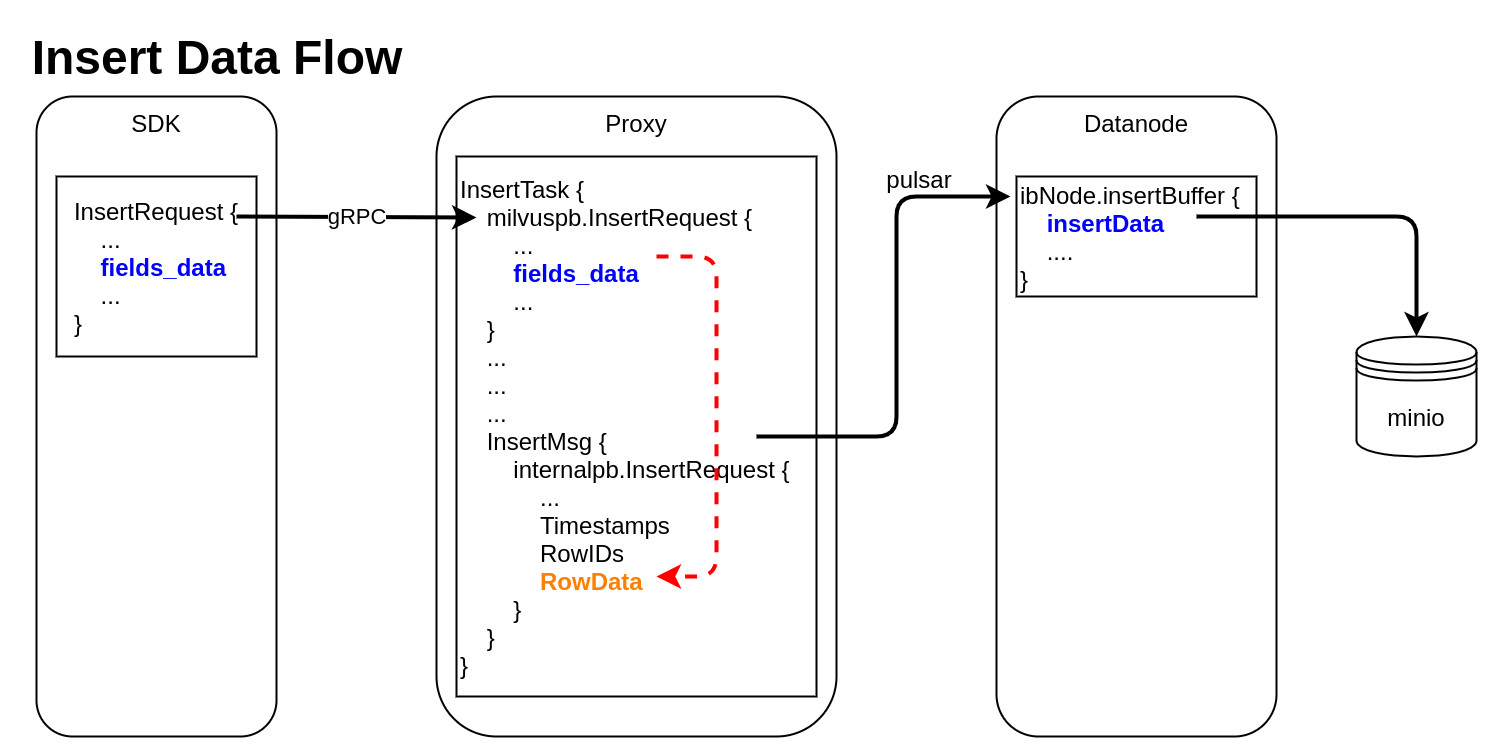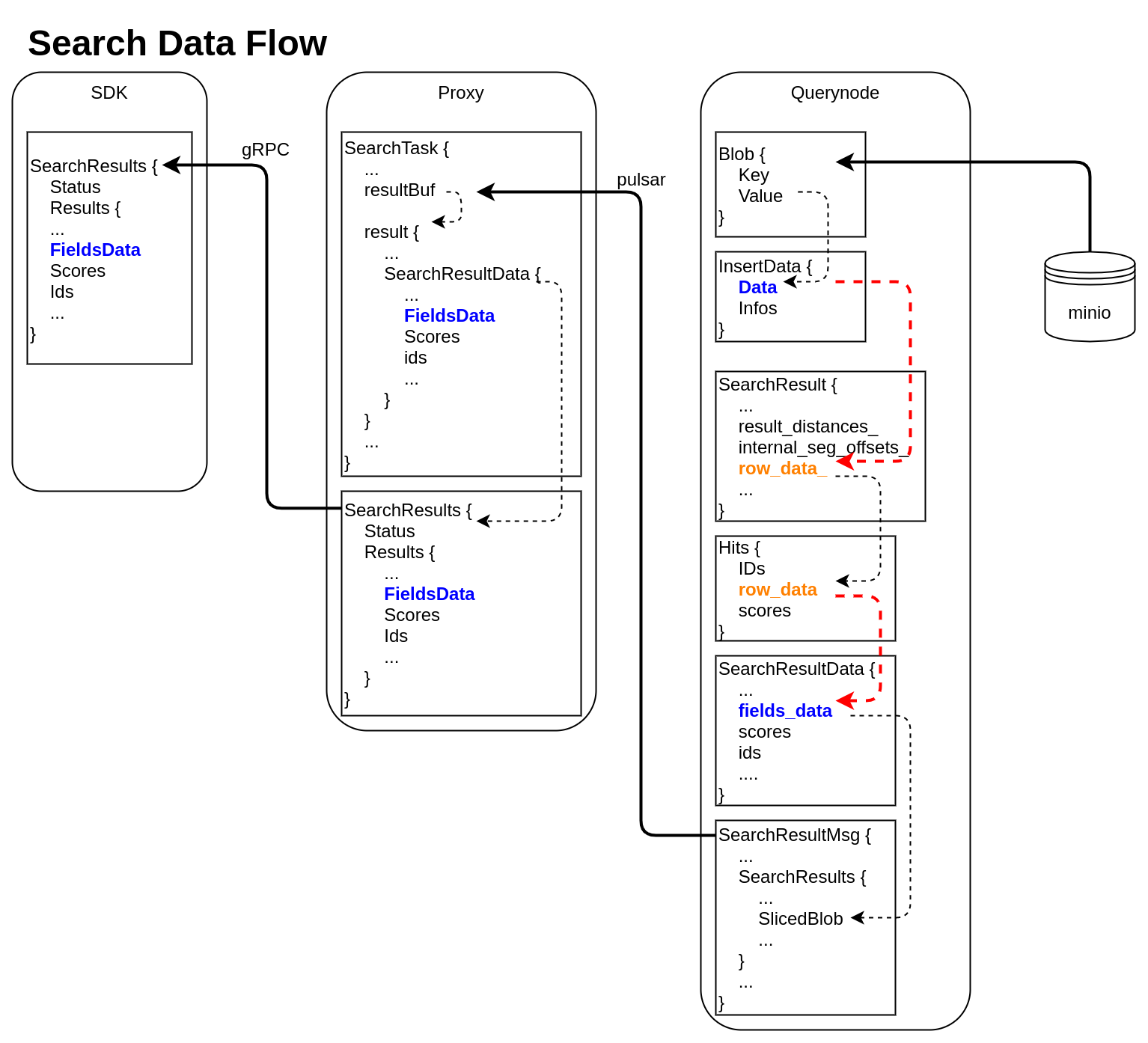Current state: "Under Discussion"
ISSUE: #7210
PRs:
Keywords: arrow
Released: Milvus 2.0
Summary(required)
What are we going to do?
Motivation(required)
From data inspect, Milvus includes 2 data flows mainly: 1). Insert data flow 2). Search data flow
Insert Data Flow
pymilvus creates a data insert request with type milvuspb.InsertRequest (client/prepare.py::bulk_insert_param)
// grpc-proto/milvus.proto message InsertRequest { common.MsgBase base = 1; string db_name = 2; string collection_name = 3; string partition_name = 4; repeated schema.FieldData fields_data = 5; // fields' data repeated uint32 hash_keys = 6; uint32 num_rows = 7; }Data is inserted into fields_data by column, schemapb.FieldData is defined as following:
// grpc-proto/schema.proto
message ScalarField {
oneof data {
BoolArray bool_data = 1;
IntArray int_data = 2;
LongArray long_data = 3;
FloatArray float_data = 4;
DoubleArray double_data = 5;
StringArray string_data = 6;
BytesArray bytes_data = 7;
}
}
message VectorField {
int64 dim = 1;
oneof data {
FloatArray float_vector = 2;
bytes binary_vector = 3;
}
}
message FieldData {
DataType type = 1;
string field_name = 2;
oneof field {
ScalarField scalars = 3;
VectorField vectors = 4;
}
int64 field_id = 5;
}milvuspb.InsertRequest被序列化后通过 gRPC 发送Proxy组件收到milvuspb.InsertRequest,为他创建任务InsertTask,并把该任务加入到执行队列中(internal/proxy/impl.go::Insert)InsertTask被执行,InsertTask.req中的 列存 数据被转换为 行存 数据,并存入另一个用于 Milvus 内部流转的消息请求internalpb.InsertRequest中 (internal/proxy/task.go::transferColumnBasedRequestToRowBasedData)internalpb.InsertRequest的定义如下:// internal/proto/internal.proto
message InsertRequest {
common.MsgBase base = 1;
string db_name = 2;
string collection_name = 3;
string partition_name = 4;
int64 dbID = 5;
int64 collectionID = 6;
int64 partitionID = 7;
int64 segmentID = 8;
string channelID = 9;
repeated uint64 timestamps = 10;
repeated int64 rowIDs = 11;
repeated common.Blob row_data = 12; // row-based data
}并为每行数据添加
rowID和timestampProxy把包含internalpb.InsertRequest的InsertMsg发送到 pulsar channel 中Datanode从 pulsar channel 中收到InsertMsg,把数据重新恢复为 列式 存储,保存在内存结构InsertData中 (internal/datanode/flow_graph_insert_buffer_node.go::insertBufferNode::Operate)type InsertData struct {
Data map[FieldID]FieldData // field id to field data
Infos []BlobInfo
}InsertData
Search Data Flow
在收到
LoadSegments请求后,会把segment对应的所有binlog文件从minio加载到内存,并放入内存数据结构Blob中 (internal/querynode/segment_loader.go::loadSegmentFieldsData)type Blob struct {
Key string // binlog file path
Value []byte // binlog file data
}通常
querynode只加载标量数据,不加载向量数据,除非该向量列未建index。Blob里的数据经过反序列化后,提取出原始数据,存入InsertData数据结构中querynode执行search请求,通过 CGO 调用knowhere搜索引擎,得到SearchResult(internal/query_node/query_collection.go::search)// internal/core/src/common/Types.h
struct SearchResult {
...
public:
int64_t num_queries_;
int64_t topk_;
std::vector<float> result_distances_;
public:
void* segment_;
std::vector<int64_t> internal_seg_offsets_;
std::vector<int64_t> result_offsets_;
std::vector<std::vector<char>> row_data_;
};knowhere返回的SearchResult中只有result_distances_和internal_seg_offsets_被填入了数据。querynode在得到所有segment返回的SearchResult后,对结果做归并,并通过internal_seg_offsets_得到其它输出列数据,并按 行存 格式写入row_data_中 (internal/query_node/query_collection.go::reduceSearchResultsAndFillData)querynode对SearchResult数据再次整理,存入数据结构milvus.Hits中// internal/proto/milvus.proto
message Hits {
repeated int64 IDs = 1;
repeated bytes row_data = 2;
repeated float scores = 3;
}milvus.Hits中的数据通过函数translateHits转为 列存 数据schemapb.SearchResultData(internal/query_node/query_collection.go::translateHits)// internal/proto/schema.proto
message SearchResultData {
int64 num_queries = 1;
int64 top_k = 2;
repeated FieldData fields_data = 3;
repeated float scores = 4;
IDs ids = 5;
repeated int64 topks = 6;
}schemapb.SearchResultData被序列化后,封装为internalpb.SearchResults,并放入msgstream.SearchResultMsg,通过 pulsar channel 发送 (internal/query_node/query_collection.go::search)// internal/proto/internal.proto
message SearchResults {
common.MsgBase base = 1;
common.Status status = 2;
string result_channelID = 3;
string metric_type = 4;
repeated bytes hits = 5; // search result data
// schema.SearchResultsData inside
bytes sliced_blob = 9;
int64 sliced_num_count = 10;
int64 sliced_offset = 11;
repeated int64 sealed_segmentIDs_searched = 6;
repeated string channelIDs_searched = 7;
repeated int64 global_sealed_segmentIDs = 8;
}proxy从 pulsar channel 中收集到所有querynode发送过来的msgstream.SearchResultMsg,反序列化得到schemapb.SearchResultData,再做一次归并,数据放入milvuspb.SearchResults,通过 gRPC 传回 SDK (internal/proxy/task.go::SearchTask::PostExecute)// internal/proto/milvus.proto
message SearchResults {
common.Status status = 1;
schema.SearchResultData results = 2;
}SDK 收到
milvuspb.SearchResults
Public Interfaces(optional)
Briefly list any new interfaces that will be introduced as part of this proposal or any existing interfaces that will be removed or changed.
Design Details(required)
Describe the new thing you want to do in appropriate detail. This may be fairly extensive and have large subsections of its own. Or it may be a few sentences. Use judgement based on the scope of the change.
## Compatibility, Deprecation, and Migration Plan(optional)
- What impact (if any) will there be on existing users?
- If we are changing behavior how will we phase out the older behavior?
- If we need special migration tools, describe them here.
- When will we remove the existing behavior?
Test Plan(required)
Describe in few sentences how the MEP will be tested. We are mostly interested in system tests (since unit-tests are specific to implementation details). How will we know that the implementation works as expected? How will we know nothing broke?
Rejected Alternatives(optional)
If there are alternative ways of accomplishing the same thing, what were they? The purpose of this section is to motivate why the design is the way it is and not some other way.
References(optional)
Briefly list all references

